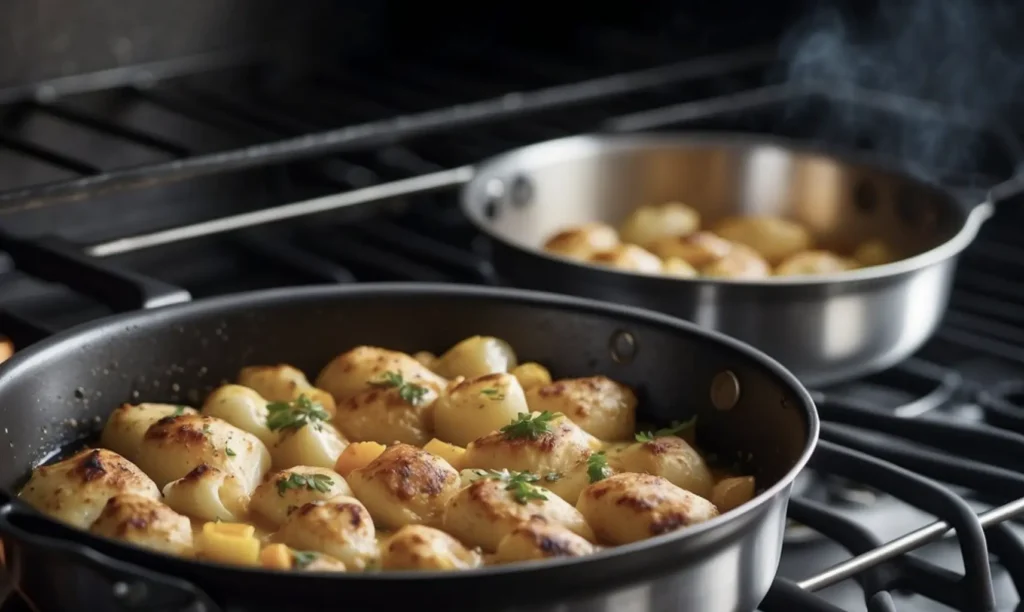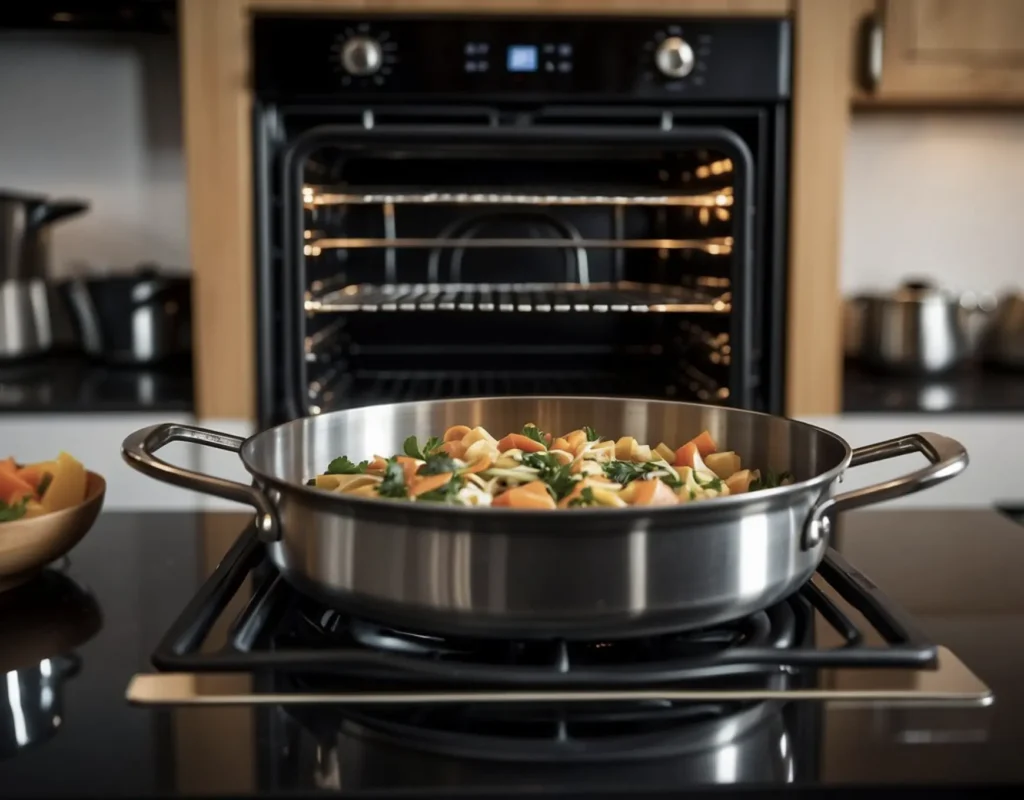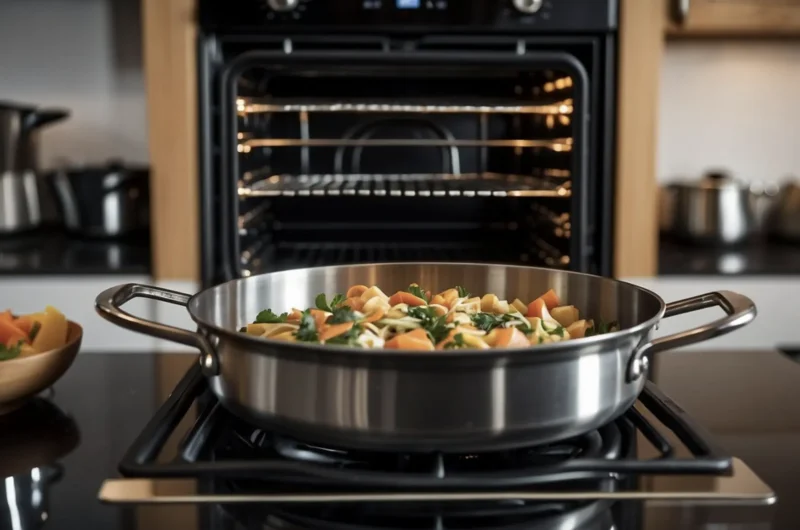When it comes to versatile cookware, I find that being able to transition from stovetop to oven is a feature I highly value. This is where Calphalon pans come into play—known for their durability and quality, I often get asked if they are oven-safe. Read on to find out if you can put a Calphalon pan in the oven. Indeed, Calphalon pans are designed to be oven-safe, which means that recipes requiring an oven finish can be started on the stove and completed in the oven without the hassle of transferring contents to an oven-proof dish.

The oven-safe temperatures for Calphalon pans differ depending on the specific collection. I’ve experienced that most Calphalon pans can safely withstand temperatures up to 400°F. However, some lines, like the Premier, Classic, and Contemporary collections, can endure up to 450°F without any damage. If I’m using the Signature, Tri-Ply, or Unison lines, I can subject them to even higher temperatures, up to 500°F, giving me a greater range for various cooking tasks.
Calphalon’s tempered glass lids are also an important consideration for oven use. In my use of them, these lids can handle oven temperatures up to 450°F. This resistance ensures that foods can be covered during the oven phase of cooking, allowing for more consistent heat distribution and moisture retention. Overall, Calphalon products have provided me with a reliable means to expand my cooking techniques with their oven-safe capabilities.
Understanding Calphalon Cookware Material

In my experience with Calphalon cookware, it’s essential to understand the material composition of their products, especially regarding how they perform at high temperatures and their suitability for oven use.
The Composition of Non-Stick Calphalon Pans
Non-stick coatings are a significant feature of Calphalon pans. I find that this coating provides an easy-release surface, which is ideal for cooking foods that tend to stick. The makeup of this non-stick surface typically includes layers of PTFE (polytetrafluoroethylene), which under normal cooking conditions, remains stable and doesn’t interact with food. However, it’s worth noting that when using Calphalon non-stick cookware, exposure to high temperatures above the manufacturer’s specified limit may compromise the integrity of the non-stick layer. Therefore, it’s crucial to adhere to these guidelines to maintain the pan’s performance and longevity.
Hard-Anodized Aluminum and Its Benefits
Hard-anodized aluminum forms the core of many Calphalon pans, including the Calphalon hard-anodized nonstick cookware. In my observation, the hard-anodizing process creates an oxidized exterior layer on the aluminum, enhancing its durability and resistance to corrosion and abrasion. As an avid cook, I appreciate that this treatment improves the metal’s heat distribution properties, leading to even cooking and preventing hot spots. Moreover, this robust material can generally withstand higher oven temperatures compared to traditional non-anodized aluminum pans. However, it’s essential to confirm the maximum temperature your specific Calphalon pan can endure, as it varies across different product lines.
Evaluating Oven-Safety Features of putting your Calphalon Pan in the oven
When assessing the oven-safety of Calphalon cookware, it is crucial that I consider both the specific collections designed for high heat and the materials used, particularly in handles, due to their varying temperature resilience.
Identifying Oven-Safe Calphalon Collections
Many Calphalon pan collections are oven-safe, but their maximum safe temperature varies. For instance, I find that Calphalon Classic pans are generally safe up to 400°F. In contrast, collections like the Calphalon Signature are crafted to endure temperatures even higher, typically up to 500°F. Here is a brief summary:
- Calphalon Classic: Safe up to 400°F
- Calphalon Signature: Safe up to 500°F
However, to ensure safety and maintain the integrity of the cookware, I always recommend verifying the product information for the exact temperature limits for your specific Calphalon collection.
Handle Material and Temperature Resilience
The handle materials on Calphalon pans range from stainless steel to rubber or silicone. For example, some Calphalon pans feature silicone comfort-grip handles which may have different temperature tolerances. Typically, stainless steel handles can withstand high oven temperatures, sometimes as high as the pan itself.
Here’s a simple breakdown:
- Stainless Steel Handles: High temperature resistant, often align with pan’s limit
- Rubber or Silicone Handles: Lower temperature limit, usually require oven mitts past a certain threshold
It is important to note that even if the pan is oven-safe, the Calphalon lids, especially if they are made of tempered glass, may not be designed for the same high heat as the pan and could shatter if exposed to extreme temperatures. Always check the maximum temperature guidance for each component to avoid any damage or accidents.
Proper Usage and Care for Longevity
In my experience, keeping Calphalon pans in peak condition hinges on proper usage and meticulous care. The methods I’ve adopted ensure that the non-stick properties last longer and the cookware remains free from permanent damage.
Avoiding Thermal Shocks to Preserve Non-Stick Properties
To prevent the non-stick surface from deteriorating, I always avoid thermal shock—sudden temperature changes that can warp metal and flake off nonstick coatings. For instance, placing a hot pan into cold water can severely damage the nonstick technology. Instead, I let the pan cool down completely before washing. When transferring Calphalon pans from the stovetop to the oven, I make certain the oven is preheated to prevent extreme temperature shifts.
Cleaning Techniques for Calphalon Cookware
Effective cleaning further extends the life of my Calphalon pans. I adhere to the following steps:
- Allow the pan to cool down completely before washing.
- Use warm water and a gentle dish soap, applying it with a non-abrasive sponge to avoid scratching the surface.
- If food residues persist, I soak the pan in warm water for a short while before cleaning again.
Through these practices, I ensure the longevity of my cookware, sustaining the top-class nonstick performance Calphalon is known for.
Maximizing Safety and Performance While Cooking
When I cook with Calphalon pans, I ensure that I’m maximizing their lifespan while keeping my meals safe by adhering to recommended temperatures and choosing the right utensils. Here’s how I do it:
Avoiding Overheating and Potential Health Risks
I’m always careful to avoid overheating my Calphalon cookware. When these pans are exposed to high temperatures, they can potentially release toxic fumes, including perfluorooctanoic acid (PFOA)—a chemical that’s been linked to health risks. To prevent this, I follow the manufacturer’s guidelines closely. For example, Calphalon’s Premier, Classic, and Contemporary collections can handle up to 450°F, while the Signature, Tri-Ply, and Unison collections withstand up to 500°F. I’ve read that some of their pans do not recommend going above 400°F, so I always check the bottom of the pan or the manual to verify the maximum temperature for my specific product.
Choosing Suitable Cooking Utensils
To prevent any damage to my pans and avoid any possibility of chemical residues being released into my food, I opt for utensils that are designed to be non-abrasive and heat-resistant. I avoid using sharp metal cooking utensils, as they can scratch the surface and break down the non-stick coating over time. Instead, I use silicone, wooden, or nylon utensils that can endure the heat without compromising the integrity of the pan. This way, I ensure that I am not ingesting any unintended substances and also help to keep my Calphalon cookware in prime condition.
Additional Considerations and Best Practices

When incorporating Calphalon pans into your cooking repertoire, it’s important to consider compatibility with various kitchen appliances and understand the brand’s diverse product lines. Adhering to usage guidelines will ensure the longevity and performance of your Calphalon cookware.
Compatibility with Other Kitchen Appliances
My Calphalon pans are designed with versatility in mind, but it’s crucial to match them with the right appliances. For instance, while stainless steel cookware is compatible with most stovetops, including induction, care must be taken to avoid combining non-stick pots and pans with any appliances that exceed recommended temperatures. Additionally, glass lids that accompany my cookware are oven-safe, but should not be placed under a broiler.
Understanding the Limitations of Specific Calphalon Lines
Each Calphalon collection, such as Unison, Contemporary, Simply Calphalon, and Calphalon Signature, has its own temperature thresholds. For example, my Calphalon Signature non-stick pans withstand up to 500°F, making them a hardy option for most baking demands. However, for Simply Calphalon or other non-stick lines, I ensure to check the specific maximum temperature to avoid damage. New cookware often comes with these details listed, so I make a practice of consulting these guidelines to guarantee my cookware’s effectiveness and durability.
Frequently Asked Questions
In this section, I’ll answer some of the most pressing questions about using Calphalon pans in the oven. I’ll cover specifics on temperature limits, handle materials, pan collections, and lid safety to ensure you can use your cookware confidently and correctly.
What is the maximum temperature for using Calphalon pans in the oven?
The maximum oven-safe temperature for Calphalon pans varies by collection. For instance, the Premier, Classic, and Contemporary collections can withstand up to 450°F, while the Signature, Tri-Ply, and Unison collections are safe up to 500°F.
| Calphalon Cookware Type | Low Heat | Medium Heat | High Heat |
|---|---|---|---|
| Nonstick | Simmer | Sauté | Fry |
| Stainless Steel | Melt | Sear | Brown |
| Cast Iron | Slow Cook | Grill | Sear |
| Ceramic | Simmer | Steam | Boil |
Is it safe to put Calphalon pans with rubber handles in the oven?
While Calphalon pans are generally oven-safe, rubber handles are not designed to withstand high oven temperatures. Always check the manufacturer’s guidelines for the specific temperature threshold.
Can Calphalon Classic nonstick pans be used in the oven?
Yes, Calphalon Classic nonstick pans are oven-safe. They can handle temperatures of up to 450°F, making them suitable for many baking and roasting tasks.
Are Calphalon glass lids oven-safe?
Calphalon glass lids are designed to be oven-safe, but they often have a lower temperature limit than the pans. Typically, these lids can endure temperatures around 450°F. Verify with your pan’s specific details to ensure safety.
How can I determine if my Calphalon pan is oven-safe?
To determine if your Calphalon pan is oven-safe, you should look for the oven-safe symbol on the bottom of the pan or check the product details on Calphalon’s official website or user manual that came with your cookware.
Are Calphalon Premier cookware pieces suitable for oven use?
Calphalon Premier cookware is designed to be oven-safe. These pieces can typically handle temperatures up to 450°F, making them versatile for different cooking methods in the oven.
Weeknight Steak and Herbs Dinner
Course: DinnerCuisine: AmericanDifficulty: Easy2
servings5
minutes20
minutesEnjoy your delicious seared steak cooked in your Calphalon pan!
Ingredients
2 thick-cut steaks (such as ribeye or New York strip)
Salt and pepper to taste
2 tablespoons of olive oil
2 tablespoons of butter
Optional: fresh herbs such as rosemary or thyme
Directions
- Preheat your oven to 400°F (200°C).
- Season the steaks generously with salt and pepper on both sides.
- Heat the Calphalon pan on the stovetop over medium-high heat and add the olive oil.
- Once the pan is hot, carefully place the steaks in the pan. Sear for 3-4 minutes on each side until a nice crust forms.
- Add the butter and optional herbs to the pan. Once the butter is melted, spoon it over the steaks to baste them.
- Transfer the entire pan to the preheated oven and continue cooking the steaks for an additional 5-10 minutes, depending on your desired level of doneness. Use a meat thermometer to check for doneness (145°F for medium rare, 160°F for medium).
- Once the steaks are cooked to your liking, remove the pan from the oven and let the steaks rest for a few minutes before serving.

